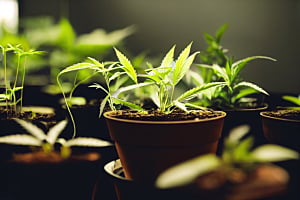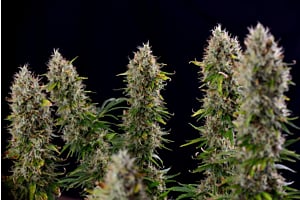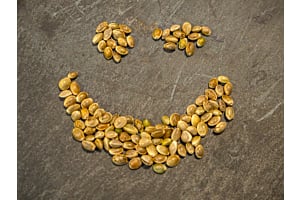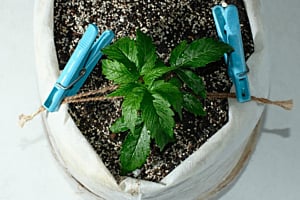When your cannabis plant is in distress, it’ll show you. It will often do so by curling the tips of its leaves downward, giving them a claw-like appearance. This is the dreaded Cannabis Claw. There are many reasons for it, but most have easy solutions!
Nitrogen Toxicity
A telltale sign of nitrogen toxicity is the deepening of the leaves’ color to a dark green, in addition to the clawing leaves curving downward at the ends. The foliage may also have a shiny appearance.
The usual cause is adding too much of the nutrient during the flowering stage of growth. The clawing leaves will eventually turn yellow or brown and fall off. Cannabis plants need ample nitrogen in the vegetative stage, but very little when they enter flowering.
If you think your plant is suffering from an overuse of nitrogen, simply cut down the amount you’re providing. If your plant is in the flowering stage, ensure you use a formula for that specific stage of growth.
If you are not giving extra nutrients, there’s a chance the nitrogen is overabundant in the soil. In this case, you will need to flush your plants with pH-balanced and filtered water to dilute the excess nutrients. If successful, the affected leaves will unlikely improve, but new growth should reflect better health.
Wind Burn
Leaf clawing can also result from too much wind. Wind burn is typically easy to spot, as the leaves further away from the fan will be fine, while those closer show clawing. Advanced wind burn can also reveal yellow-spotted leaves.
The good news is that wind burn is easy enough to remedy by simply lowering the speed or changing the direction of the fan or relocating the plant itself to reduce its exposure.
Overwatering
Clawing can also result from overwatering. A droopy appearance is a trademark of overwatering. If combined with high heat, overwatering can result in leaves that turn upward.
It’s trial and error to find out, so if you think overwatering is the case with your plant, simply water less and see what results. Always allow the soil to dry completely between waterings.
Underwatering
One of the most common reasons for cannabis clawing and the easiest to fix, is underwatering. You can generally tell if underwatering is the culprit if the plant perks up after watering.
If that’s the case, it’s the easiest fix of all – just provide more water, making sure you saturate the soil thoroughly.
Bad Soil
There are many options when it comes to choosing a growing medium for your cannabis plants. The medium here refers to the substance you’ve opted to grow your plants in. Options vary from soil of different types, perlite, or coco coir, and many others. You may choose a different soil for outdoor growth as well as for cultivating weeds indoors.
A plant needs oxygen, water, and nutrients to grow and be healthy. If you’re using a traditional soil or soilless medium like coco coir, proper drainage is essential. If the water for the plant doesn’t have anywhere to go, it will begin pooling at the roots and eventually cause rot.
Another tip is to allow the soil or coco to dry completely between waterings. If the soil has become muddy and compacted, chances are it will need to be replaced. Healthy soil is dark in color and has a fluffy texture ideal for both retaining water and drainage. Adding perlite or some small pebbles to the soil will help to keep it aerated and draining properly.
Root Problems
Root issues could be the core problem behind your clawing leaves. Generally, plants with root disease exhibit other symptoms in addition to clawing. Leaf discoloration is one sign. Usually, yellowing or spots, sometimes brown but can be red and other colors as well. So-called leaf septoria is another satellite of claw-like leaf shape. If the runoff water has a bad odor, that’s a clear indication of root issues.
Root problems are often prevented by starting with good soil and drainage and keeping temperatures at an ideal range.
Root Rot
Roots can also develop rot. Root rot often mimics the signs of over or underwatering – small, clawing leaves, turning downward or upward and small size. If you are able to eliminate overwatering or underwatering as the cause, then your plant may be suffering from root rot.
Rotting roots appear brown and slimy and often twist up together in addition to producing a bad odor. Healthy roots appear white or cream in color and fluffy in appearance. The reasons for root rot are plentiful. If you’re growing in soil or coir, a likely cause is a stagnant water.
Some growers use hydrogen peroxide to treat root rot. Though it can be effective, the results are generally temporary. Though good at killing the harmful bacteria that cause root rot, it also kills the good bacteria meant to prevent it. It’s advised to use a solution specifically for cannabis that targets the bad bacteria specifically. There are some great commercially available products that provide beneficial bacteria that work to counteract fungi and harmful bacteria.
If you’re successful at combating root rot, you’ll start to see new root growth that appears white and healthy. The old brown roots will end up further down. Some choose to clip off those areas, but it’s not necessary if you see the new growth is healthy.
Unhealthy Roots in Soil/Coco
Growing cannabis plants in soil versus coco coir is a very different experience. Soil is definitely more straightforward and can be beneficial in terms of nutrients provided and water retention. Growing in coco tends to be more time-consuming as watering and nutrients must be managed and provided more often.
Although root disease can develop with either medium, unhealthy roots from heat, overwatering and rot are more likely with soil than coco. A great benefit of coco is root aeration, but water retention is more difficult, often leading to underwatered roots.
Rootbound
Another consideration for ideal root health is giving your plant enough room to breathe and grow. Having a container that restricts the roots is going to result in stunted growth and an unhealthy plant. A plant becoming rootbound occurs when the roots have outgrown the container and start wrapping around with nowhere else to go. In this case, the cannabis plant should be transplanted into a larger pot.
Heat Stress
Temperature is a core issue for root health. Heat stress is a common cause of cannabis claw and can promote the conditions for root rot to develop. Leaves exhibiting signs of stress from heat may appear downturned and may be brown at the tips.
Although cold is also not favorable for roots, it’s a less common problem in growing cannabis. Generally, the ideal temperature for cannabis is a comfortable room temperature during the day and a slightly cooler temperature overnight. Cannabis is resilient and can grow in temperatures ranging from 50-82℉, but the ideal temperature range is around 75℉.
Light Burn
Another potential reason for clawing leaves in cannabis is light burn. Oftentimes heat stress and light burn occur simultaneously, though light burn can occur in otherwise ideal conditions. Indoor grows are more prone to light burn due to the grow lights used. Much like wind burn, the evidence of light burn will likely occur where the plant is closest to the source. In this case, the curling and yellowing will occur to the leaves near the top, closest to the lights.
The solution is to move the affected plants farther away from the lights or to raise them to an appropriate height.
Excessive Use of Fertilizers
Overuse of fertilizer is another factor in clawing cannabis leaves. Much like water, your plants need nutrients to grow and thrive, but overdoing it can be detrimental to their health. It’s generally not recommended to add fertilizer to young plants until they’re better established and able to handle different stressors.
Nitrogen toxicity is just one consideration when it comes to an overabundance of nutrients. Potassium and phosphorus can also promote curling and even burning of the leaves if given throughout the flowering stage.
Bugs & Pests
Like all vegetation, cannabis plants are subject to the infestation of bugs & pests. The main culprits are aphids and mites, which attach to the undersides of leaves and feed on their nutrients. As the leaves are consumed, they will start to curl downward and feel dry to the touch. Leaves may continue to show damage and turn yellow.
Infestation must be dealt with immediately as a few can turn into many and impact the entire plant or crop if intervention isn’t swift.
Prevention is the best cure
If you’re just embarking on your cannabis-growing journey, look for our selection of seeds for beginners.
It’s advised to start with the best possible set-up initially so that your plants don’t fall victim to clawing leaves and other symptoms. The best approach includes:
- Ensuring your container is large enough to accommodate your plant’s growth.
- Watering only when needed, letting the soil dry completely in between.
- Maintaining a comfortable temperature (ideally under 75℉ and slightly cooler at night).
- Clearing the plant’s soil or water of organic debris.
- Keeping the soil or water aerated.
- Shielding your plants’ roots from light.
- Keeping pests away
Now that you know more about growing pitfalls to avoid, it’s time to get started! Get your seeds today!

 THC
THC







